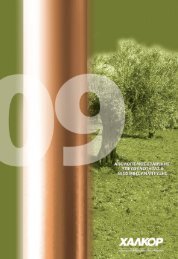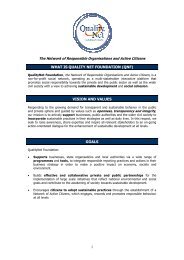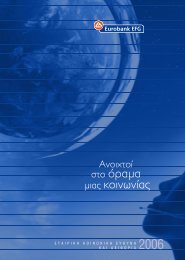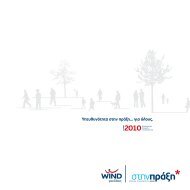APOLOGISMOS CCHBC final - Coca-Cola Hellenic
APOLOGISMOS CCHBC final - Coca-Cola Hellenic
APOLOGISMOS CCHBC final - Coca-Cola Hellenic
Create successful ePaper yourself
Turn your PDF publications into a flip-book with our unique Google optimized e-Paper software.
workplace workplace workplace workplace workplace workplace workplace workplace workplace workplace workplace workplace workplace workplace workplace workplace workplace workplace workplace workplace<br />
Ensure the regular communication of the<br />
Company’s status, and where appropriate,<br />
progress in the implementation of policies,<br />
strategies, regulatory compliance and engagement<br />
with all stakeholders.<br />
As part of the company’s commitment to best<br />
practice in corporate governance, it maintains various<br />
measures to enhance internal control and<br />
management, and it continues to institute others<br />
as its business grows and evolves. These measures<br />
include a permanent Internal Audit function,<br />
which reports to the audit committee and<br />
approves the internal audit work for each year.<br />
The internal audit department comprises 16 fulltime<br />
internal staff covering a range of disciplines<br />
and business expertise. The head of the internal<br />
audit department makes regular presentations to<br />
the audit committee.<br />
A Disclosure Committee has recently been<br />
established which reports to the Audit Committee.<br />
The committee is responsible for the implementation<br />
of controls and procedures to ensure the<br />
accuracy and completeness of the company’s public<br />
disclosures.<br />
The company also has in place a Risk<br />
Management function for the identification,<br />
assessment and control of key business risks.<br />
Risks covered are those arising from a range of<br />
sources in three broad categories: the external<br />
environment in which the business operates, the<br />
business processes, and the information available<br />
for business decisions. The risk identification and<br />
assessment process has been incorporated as<br />
part of the company’s annual business planning<br />
process since 2001. This covers all countries and<br />
involves senior management of the company and<br />
of each business unit. The process enables a regular<br />
review to take place by management of the<br />
risks associated with the business and the plans to<br />
address them.<br />
To assist in this process, the business looks to external parties<br />
for independent assessment and includes:<br />
Aon, our external risk advisors, work with our risk management<br />
function to provide a comprehensive Safety &<br />
Loss Prevention (SLP) programme across all territories.<br />
The structure of the programme includes:<br />
ñ Property Loss Prevention<br />
ñ Business Continuity Planning<br />
ñ Worker Safety (leading to OHSAS 18000)<br />
ñ Fleet Safety Management<br />
ñ Environmental Safety Management<br />
(leading to ISO 14001)<br />
Denkstatt, our external environmental advisors who<br />
work with our technical function to provide third party<br />
verification of our Environmental programme including:<br />
ñ The appropriateness of the mechanisms of Key<br />
Performance Indicators<br />
ñ The traceability and accuracy of the data collected.<br />
ñ The analysis of the data collected, reporting and consistency<br />
of the data.<br />
ñ The availability of the data for external scrutiny.<br />
Lloyd’s Register Quality Assurance & Société<br />
Générale Surveillance International are Certification<br />
Bodies, who externally validate our systems, procedures<br />
and practices against international standards and management<br />
systems. These include:<br />
ñ ISO 9000/2000<br />
ñ ISO 14001<br />
ñ Occupational Health & Safety Series 18001<br />
DIRECTORS<br />
Under the company’s articles of association, the<br />
Board of Directors must consist of a minimum of<br />
7 and a maximum of 15 members. Currently there<br />
are 11 Board Members and there is no age retirement<br />
requirement. Shareholders appoint the<br />
board of directors for a three-year term at a general<br />
meeting.<br />
<strong>Coca</strong>-<strong>Cola</strong> HBC complies with a recently enacted<br />
Greek law pertaining to the appointment of directors<br />
and the constitution of the Board. Further<br />
details of the legal compliance of board practices<br />
can be found in the <strong>Coca</strong>-<strong>Cola</strong> HBC Annual report<br />
on Form 20-F which is submitted to the New York<br />
Stock exchange and is available on the <strong>Coca</strong>-<strong>Cola</strong><br />
HBC website at www.coca-colahbc.com.<br />
Ten of the eleven Board members are non-executive<br />
and three members are independent, with the<br />
remainder representing the two largest shareholders,<br />
who together comprise 64% of shareholding.<br />
An independent director is a person who<br />
does not have any direct or indirect relationship<br />
with the company or its affiliates that would interfere<br />
with the exercise of independent judgement.<br />
In seeking to appoint members to the Board,<br />
<strong>Coca</strong>-<strong>Cola</strong> HBC is mindful of its responsibilities to<br />
identify and propose candidates who will provide a<br />
proper balance of knowledge and expertise that<br />
will help to fulfil the company’s commitment to all<br />
its stakeholders. Major <strong>Coca</strong>-<strong>Cola</strong> HBC shareholders,<br />
in particular The <strong>Coca</strong>-<strong>Cola</strong> Company, have<br />
extensive experience in matters relating to corporate<br />
behaviour across numerous countries.<br />
Directors with considerable depth and breadth of<br />
experience in environmental and social issues have<br />
been appointed. They provide valuable assistance<br />
in guiding the strategic direction of the company in<br />
these areas.<br />
Committees established by <strong>Coca</strong>-<strong>Cola</strong> HBC to<br />
overview the economic, environmental and social<br />
aspects of the company are required to report<br />
regularly to the Board of Directors. The content of<br />
such reports, covering action taken and the identification<br />
of challenges or opportunities, are used<br />
by Board Members to determine appropriate<br />
responses, in line with strategic planning.<br />
Mechanisms are in place for designated Board<br />
Members to be alerted to matters requiring immediate<br />
attention. If considered necessary, a full meeting<br />
of the Board can be convened to respond swiftly.<br />
As a general matter, the Board of Directors convenes<br />
the Annual General Meeting and determines<br />
the items on the agenda. However, shareholders<br />
holding 5% or more of <strong>Coca</strong>-<strong>Cola</strong> HBC shares also<br />
have a right to convene a general meeting of<br />
shareholders.<br />
A quorum of 67% of the holders of the share capital<br />
and a supermajority of 90% of the share capital<br />
present and entitled to vote is required to pass<br />
any resolution concerning a change to the Group’s<br />
“objects and purposes”.<br />
DIRECTORS’ AND SENIOR<br />
EXECUTIVE COMPENSATION<br />
To achieve the business results required by <strong>Coca</strong>-<br />
<strong>Cola</strong> HBC, the company must attract, retain and<br />
motivate high calibre executives for whom it recognises<br />
there is an international market. The Human<br />
Resources Committee aims to provide total com-<br />
14<br />
15







